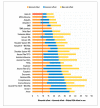Lateralization in Reverse Shoulder Arthroplasty
- PMID: 34830659
- PMCID: PMC8623532
- DOI: 10.3390/jcm10225380
Lateralization in Reverse Shoulder Arthroplasty
Abstract
Indications for Reverse Shoulder Arthroplasty (RSA) have been extended over the last 25 years, and RSA has become the most frequently implanted shoulder arthroplasty worldwide. The initial Grammont design with medialization of the joint center of rotation (JCOR), placement of the JCOR at the bone-implant interface, distalization and semi-constrained configuration has been associated with drawbacks such as reduced rotation and range of motion (ROM), notching, instability and loss of shoulder contour. This review summarizes new strategies to overcome these drawbacks and analyzes the use of glenoid-sided, humeral-sided or global bipolar lateralization, which are applied differently by surgeons and current implant manufacturers. Advantages and drawbacks are discussed. There is evidence that lateralization addresses the initial drawbacks of the Grammont design, improving stability, rates of notching, ROM and shoulder contour, but the ideal extent of lateralization of the glenoid and humerus remains unclear, as well as the maximal acceptable joint reaction force after reduction. Overstuffing and spine of scapula fractures are potential risks. CT-based 3D planning as well as artificial intelligence will help surgeons with planning and execution of appropriate lateralization in RSA. Long-term follow-up of lateralization with new implant designs and implantation strategies is needed.
Keywords: BIO-RSA; ROM; Reverse Shoulder Arthroplasty (RSA); bipolar lateralization; lateralization; notching; shoulder prosthesis.
Conflict of interest statement
George Athwal and Gilles Walch receives royalties from Stryker.
Figures









References
-
- Grammont P.M., Trouilloud P., Laffay J., Deries X. Etude et Réalisation D’une Nouvelle Prothèse D’épaule. [(accessed on 28 July 2020)]. Available online: https://www.semanticscholar.org/paper/Etude-et-r%C3%A9alisation-d%27une-....
-
- Bauer S., Walch G., Athwal G. Patient-Specific Lateralization, Glenoid Offset, Implications and Operative Strategy. Lead. Opin. Orthopädie Rheumatol. 2020;4:22–27.
-
- Ernstbrunner L., Andronic O., Grubhofer F., Camenzind R.S., Wieser K., Gerber C. Long-Term Results of Reverse Total Shoulder Arthroplasty for Rotator Cuff Dysfunction: A Systematic Review of Longitudinal Outcomes. J. Shoulder Elb. Surg. 2019;28:774–781. doi: 10.1016/j.jse.2018.10.005. - DOI - PubMed
Publication types
LinkOut - more resources
Full Text Sources

